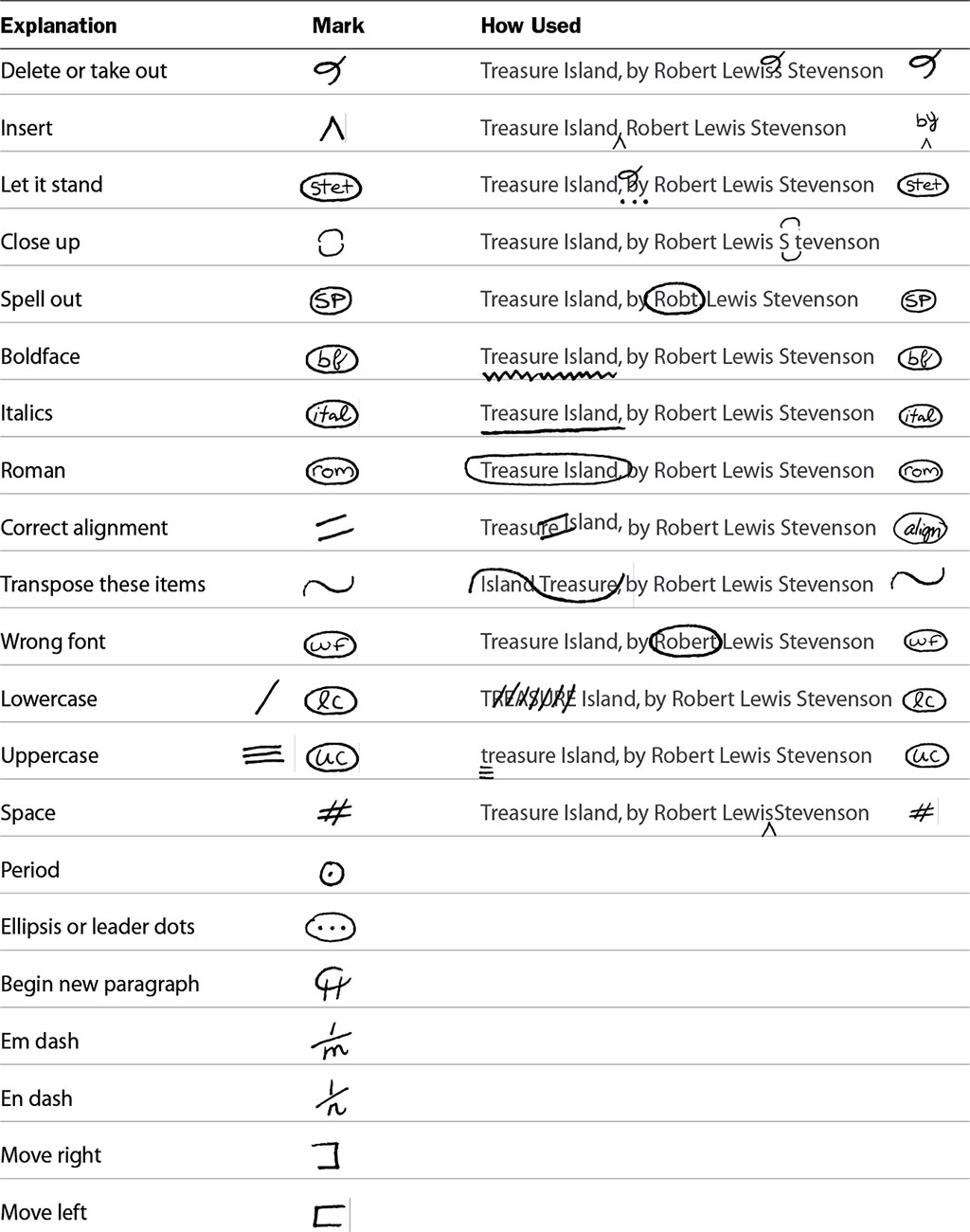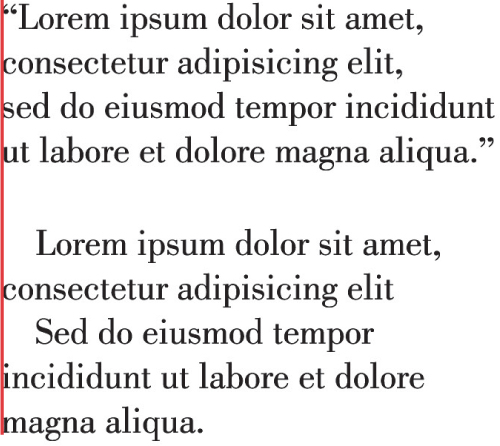Chapter 3: Proofreading and Copywriting
PROOFREADERS’ SYMBOLS
These marks and notations are widely used and understood by editors, proofreaders, and others involved in writing and producing text. Use them when proofing or editing a manuscript or proof.

FOOTNOTES
Notes and footnotes always end with periods, even if they do not form complete sentences. Source lines do not end in periods. Use the following sequence when listing more than one footnote per page:
* First footnote
† Second footnote
** Third footnote
‡ Fourth footnote
ABBREVIATION GUIDE
When to abbreviate a word or name and how to abbreviate it will vary, depending on how it is used. Consult the following categories for usage advice on any given term or name and its abbreviation.
Time Designations
When designating an hour of the day, use figures for clock time followed by a.m. and p.m. Midnight, noon, 12:00 midnight, or 12:00 noon are preferred to 12:00 p.m. or 12:00 a.m. Use AD preceding the year, with no comma (AD 2004); BC following the year, with no comma (115 BC). Use abbreviations for seconds, minutes, hours, weeks, and months in tables and charts only. Spell out in all other situations.
| Meaning | Abbreviation |
| after the birth of Christ | AD or A.D. |
| before the birth of Christ | BC or B.C. |
| before noon | a.m. |
| after noon | p.m. |
| century | cent. |
| year | yr. |
| month | mo. |
| months | mos. |
| week | wk. |
| hour | hr. |
| minute | min. |
| seconds | sec. |
| Monday | Mon. |
| Tuesday | Tues. |
| Wednesday | Wed. |
| Thursday | Thur. |
| Friday | Fri. |
| Saturday | Sat. |
| Sunday | Sun. |
| Meaning | Abbreviation |
| January | Jan. |
| February | Feb. |
| March | Mar. |
| April | Apr. |
| May | May |
| June | June |
| July | July |
| August | Aug. |
| September | Sep. |
| October | Oct. |
| November | Nov. |
| December | Dec. |
United States State Abbreviations
When the name of a U.S. state appears as part of a complete mailing address, use the postal service abbreviation.
| State | Postal Service Abbreviation |
| Alabama | AL |
| Alaska | AK |
| Arizona | AZ |
| Arkansas | AR |
| California | CA |
| Colorado | CO |
| Connecticut | CT |
| Delaware | DE |
| District of Columbia | DC |
| Florida | FL |
| Georgia | GA |
| Hawaii | HI |
| Idaho | ID |
| Illinois | IL |
| Indiana | IN |
| Iowa | IA |
| Kansas | KS |
| Kentucky | KY |
| Louisiana | LA |
| Maine | ME |
| Maryland | MD |
| Massachusetts | MA |
| Michigan | MI |
| Minnesota | MN |
| Mississippi | MS |
| Missouri | MO |
| Montana | MT |
| Nebraska | NE |
| Nevada | NV |
| New Hampshire | NH |
| New Jersey | NJ |
| New Mexico | NM |
| New York | NY |
| North Carolina | NC |
| North Dakota | ND |
| Ohio | OH |
| Oklahoma | OK |
| Oregon | OR |
| Pennsylvania | PA |
| Rhode Island | RI |
| South Carolina | SC |
| South Dakota | SD |
| Tennessee | TN |
| Texas | TX |
| Utah | UT |
| Vermont | VT |
| Virginia | VA |
| Washington | WA |
| West Virginia | WV |
| Wisconsin | WI |
| Wyoming | WY |
United States Territories
| Territory | Postal Service Abbreviation |
| American Samoa | AS |
| Federated States of Micronesia | FM |
| Guam | GU |
| Marshall Islands | MH |
| Palau | PW |
| Puerto Rico | PR |
| Virgin Islands | VI |
UNITED STATES
| mile | mi. |
| yard(s) | yd. |
| foot | ft. |
| inch | in. |
| ton(s) | t. |
| pounds | lb. |
| ounces | oz. |
| pint | pt. |
| quart | qt. |
| gallon | gal. |
| horsepower | hp. |
| miles per gallon | mpg |
| miles per hour | mph |
INTERNATIONAL
| kilometer | km |
| meter | m |
| centimeter | cm |
| millimeter | mm |
| metric ton | t |
| kilogram | kg |
| gram | g |
| liter | L |
| milliliter | mL |
| British thermal unit | Btu |
| calorie | cal. |
| hectare | ha |
| hertz | Hz |
Common Prefixes
| Prefix | Symbol | Factor |
| mega | M | 1,000,000 |
| kilo | k | 1,000 |
| centi | c | 1/100 |
| milli | m | 1/1,000 |
HYPHENATION GUIDE
There are differences in length between the hyphen (-), the en dash (–) and the em dash (—). An en dash is roughly the width of an n; an em dash is the width of an m. Each has its proper place in written language.
Hyphen: Use in words that are broken over two lines (pro-ject), fractions (a two-thirds majority), multiple modifiers (part-time employee) or in a compound adjective, verb, or adverb (Italian-American).
En dash: Use to indicate ranges in a numerical sequence (January 23–25, 2001; pages 53–66; 1–2 tbsp of sugar), in other designations of time (May–June), or when combining open compounds (Maryland–Virginia border).
Em dash: Use as punctuation in place of a semicolon or a colon (The computer industry was in full bloom—many technological methods were well established), or to indicate a pause of thought, or to precede a quote attribution (“Never mistake motion for action.”—Ernest Hemingway).
PRIME MARKS AND QUOTATION MARKS GUIDE
Prime marks: Use to indicate inches (8" deep dish pizza) and feet (He is 6'2 " with green eyes.) Never use in place of quotation marks or apostrophes.
Quotation marks: Use to indicate opening and closing of a quote (“This is a proper use of quotation marks,” she said.) Use single close quote mark as apostrophes for contractions or possessions (That’s Ethan’s toy.)
Hanging punctuation: also known as exdentation, is the proper way to treat quotation marks and bullet points to keep a clean margin of alignment.

Improper typesetting of quotation marks and bullet points where the punctuation disrupt the body of text and break the margin of alignment.

